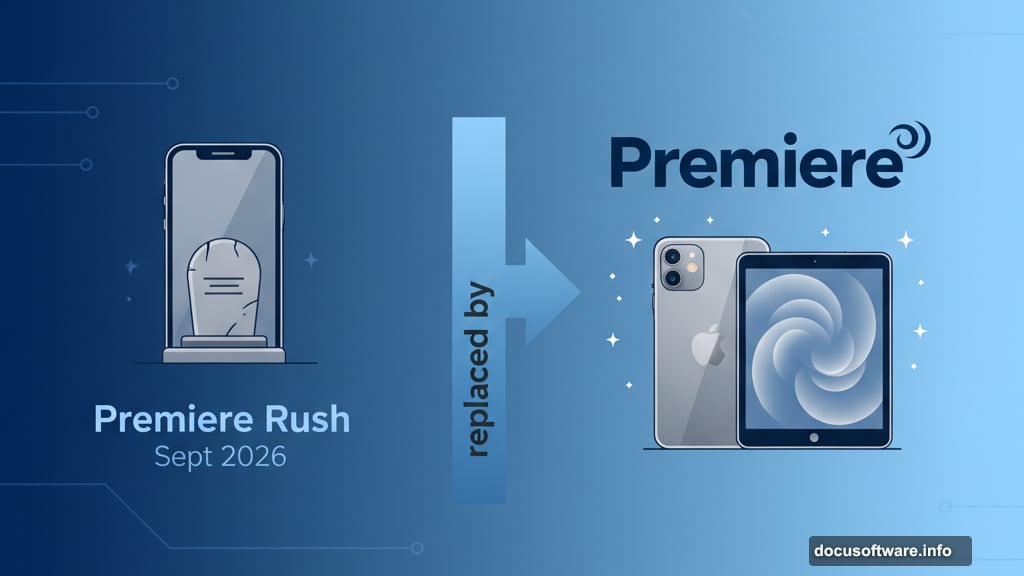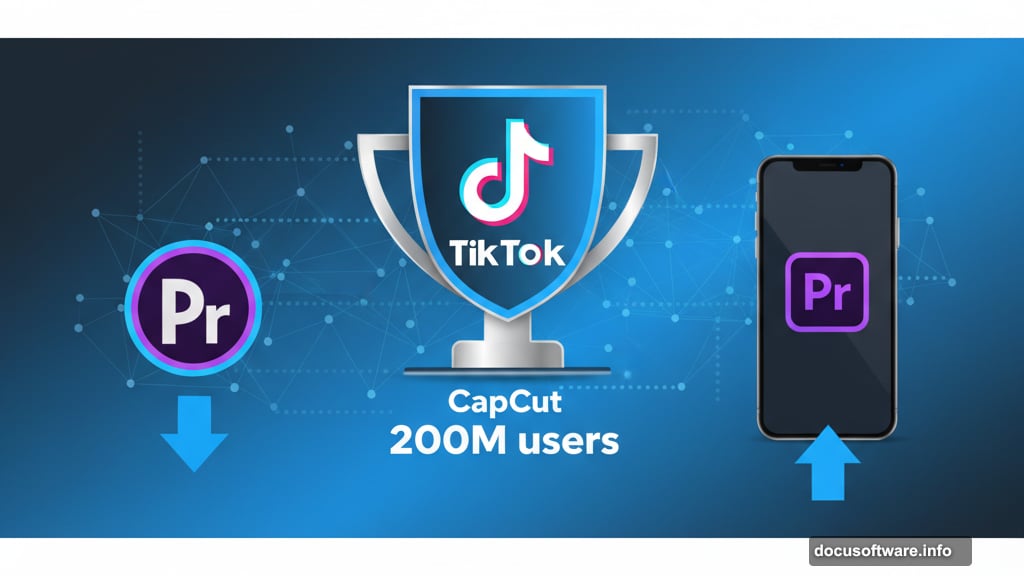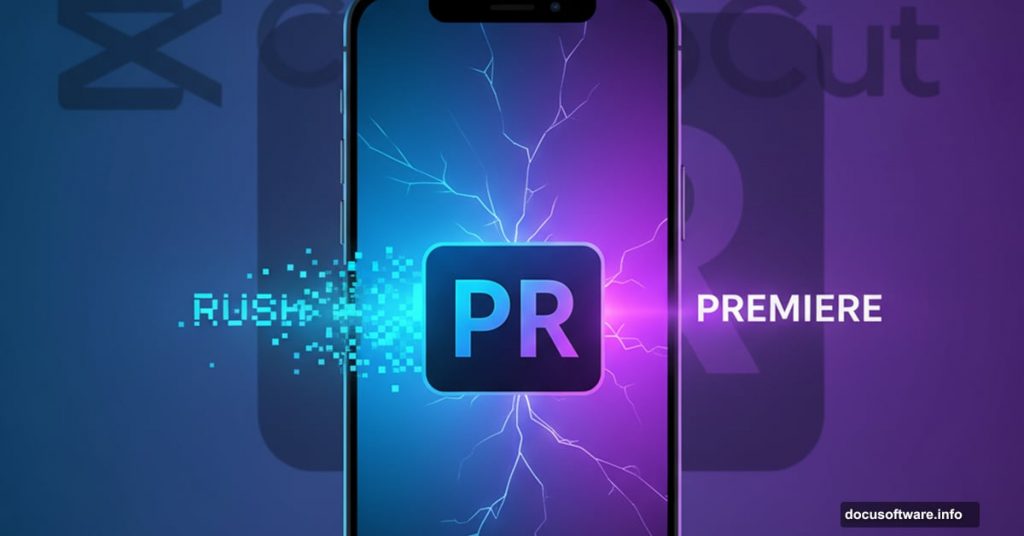Adobe dropped Premiere on iPhone and iPad today. No warning. No fanfare. Just a complete replacement for their mobile video editor.
The new app brings desktop-level editing to your phone. But there’s a catch that most people will miss until it’s too late.
Premiere Rush is Dead. Long Live Premiere
Adobe officially pulled the plug on Premiere Rush. The lightweight mobile editor that millions used? Gone by September 2026.
Existing Rush users can still access the app on devices where it’s already installed. But that’s it. No updates. No new features. No support after the deadline.
Meanwhile, the new Premiere app for iPhone and iPad promises “pro-quality video editing” on mobile devices. Adobe built it from scratch with features that Rush never offered.
So what changed? Everything about how mobile editing works.
What Makes the New App Different
Premiere for iPhone brings unlimited multi-track timelines to mobile for the first time. You can layer video, audio, and text without hitting arbitrary limits.
That matters more than it sounds. Most mobile editors cap you at three or four tracks. Need to overlay multiple audio sources? Add complex graphics? Stack video effects? You hit the ceiling fast.
Plus, the app includes tools that used to require a desktop. Speech enhancement removes background noise and isolates voices automatically. The caption system generates stylized subtitles on the fly. HDR export supports full 4K resolution.
Adobe also baked in Firefly AI directly. You can generate sound effects, create assets, and enhance footage without leaving the app. Those features cost extra. But they exist natively instead of requiring desktop software.
The Pricing Twist Nobody Saw Coming
Here’s where things get interesting. Premiere for iPhone and iPad is free.
Wait. Free? Adobe’s flagship video editor that costs $23 monthly on desktop? Available at no charge on mobile?
Not exactly. The base app works without a subscription. But Adobe locked the good stuff behind paywalls.
Generative AI features require credits. Advanced cloud storage needs Creative Cloud subscriptions. Export options have limits. So you can edit for free. But serious work costs money eventually.
Still, that’s a massive departure from Premiere Pro’s pricing model. Adobe clearly wants people using their tools on mobile. Even if they don’t pay immediately.
CapCut Forced Adobe’s Hand

Let’s be honest about why this happened. CapCut crushed Adobe in the mobile editing space.
The free app from ByteDance (TikTok’s parent company) grew to over 200 million users. It offered AI-powered editing, unlimited tracks, and social media integration that Rush couldn’t match.
Adobe watched CapCut dominate the market they invented. Now they’re playing catch-up with features CapCut normalized years ago.
One-tap publishing to TikTok, YouTube, and Instagram? CapCut did it first. Automatic captions with style presets? CapCut shipped it in 2022. AI-generated effects? Also CapCut.
So Adobe rebuilt their mobile strategy from scratch. The new Premiere app directly targets CapCut users with similar features and workflows. They’re admitting defeat on Rush and starting over.
The Desktop Connection Actually Works
Projects created in Premiere for iPhone transfer directly to Premiere Pro on Mac or PC. No conversion. No compatibility issues. No lost features.
That’s huge for professionals who start edits on mobile. You can capture footage on iPhone, do rough cuts during your commute, then finish the project on desktop without rebuilding everything.
Most mobile editors export to video files that you re-import on desktop. That loses project structure, timelines, and editing flexibility. Adobe’s approach preserves everything.
But here’s the reality check. Most people editing on phones never touch desktop software. So this seamless workflow benefits a tiny percentage of users. The rest just want quick edits for social media.
Adobe built enterprise features into a consumer product. That works for their brand positioning. It’s less clear if casual editors care.
iMovie Still Can’t Handle Portrait Video
Meanwhile, Apple’s iMovie for iOS still doesn’t support portrait-oriented video. In 2025. When vertical video dominates social media.
Think about that. Instagram Reels, TikTok, YouTube Shorts – all vertical. Yet iMovie forces you into landscape orientation or awkward workarounds.
Adobe saw this gap and exploited it. Premiere for iPhone handles portrait video natively. It treats vertical content as the default, not an afterthought.
That’s a direct shot at Apple’s complacency. iMovie hasn’t evolved meaningfully in years. So Adobe seized the opportunity to offer what Apple won’t.
Android Users Get Nothing Yet
Premiere for iPhone launched today. Premiere for Android? “In development.”
No timeline. No feature list. No commitment beyond “we’re working on it.”

That’s frustrating for the majority of smartphone users globally. Android dominates market share outside the US. But Adobe prioritized iOS first.
Likely reasons? iOS users spend more on apps. Apple’s ecosystem integrates better with creative workflows. Development is simpler on fewer device types.
Still, it’s a massive missed opportunity. CapCut works great on Android. Adobe is conceding that market before they even compete.
Who Actually Edits Seriously on Mobile
Real talk. How many professionals do serious video editing on phones or tablets?
Some. Mostly journalists, content creators, and social media managers who need fast turnarounds. But heavy editing? Complex projects? Multi-hour cuts? Everyone uses desktop software.
Mobile editing tools excel at quick content. Shoot something. Trim it. Add captions. Post it. That workflow works brilliantly on phones.
But the promise of “pro-quality editing” on iPhone feels like marketing more than reality. Professional work still requires desktop power, larger screens, and precise control.
Adobe wants you to believe your iPhone replaces your Mac. It doesn’t. Not for real work.
The new Premiere app offers impressive capabilities. But it’s ultimately a content creation tool for social media, not a professional editing suite.
Adobe’s Real Strategy
This launch isn’t about mobile editing. It’s about ecosystem lock-in.
Adobe wants you using their tools everywhere. Phone, tablet, desktop. They want your projects living in Creative Cloud. They want you dependent on their AI features.
So they made the mobile app free to pull you in. Once you’re invested, upgrading to paid features or desktop software becomes easier. Your projects already exist in Adobe’s system.
It’s the same strategy Adobe used with free Creative Cloud trials. Give people tools. Make them valuable. Convert them to paying customers later.
Smart business. Less great for users who thought “free” meant actually free.
The new Premiere app is powerful. It’s also the first step in Adobe’s plan to monetize your entire creative workflow. Choose accordingly.
